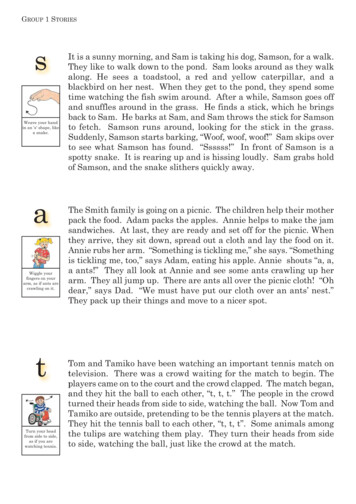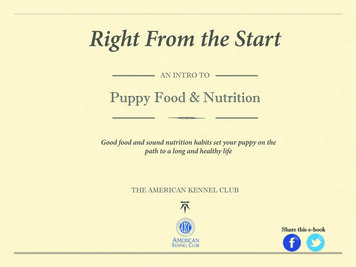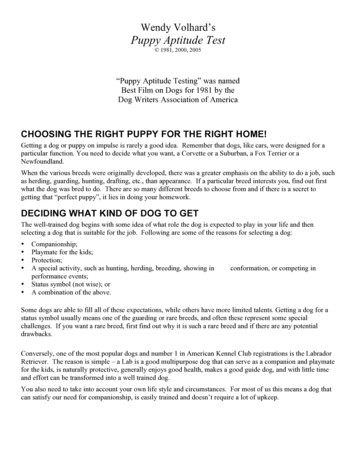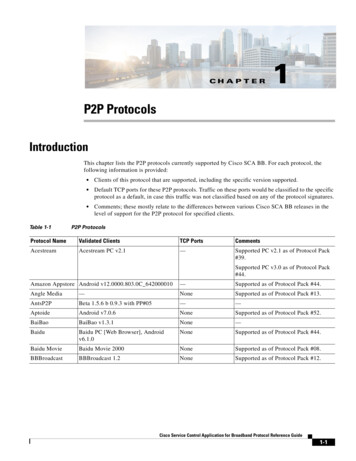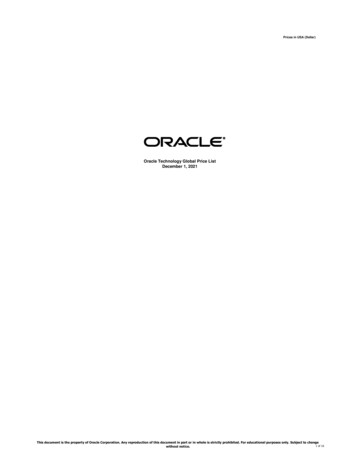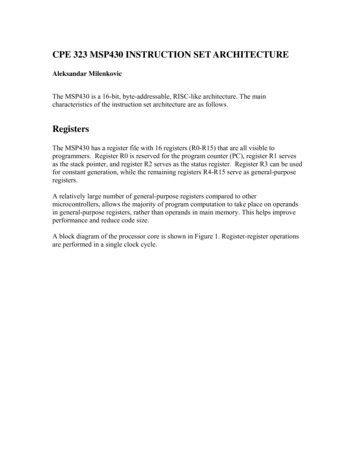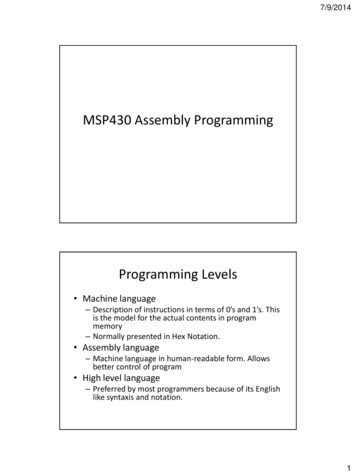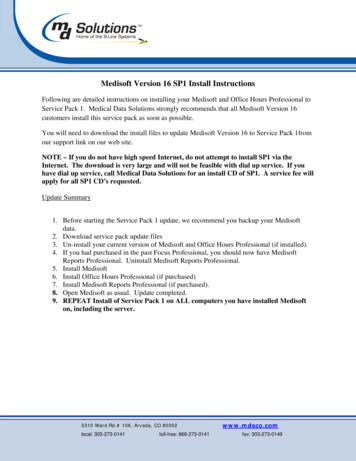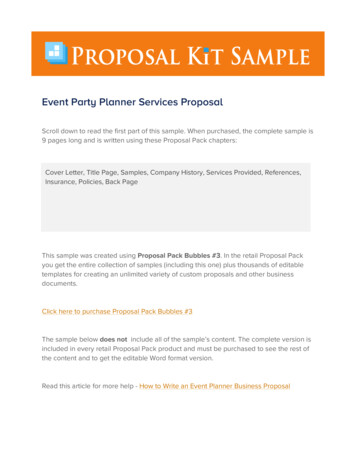
Transcription
Thank you for downloading The Kennel Club Assured Breeders scheme puppy information packtemplate.These instructions have been designed to help you create a puppy information pack that providesinformation that puppy buyers will find essential, and that meets the requirements of the AssuredBreeders scheme. You may add further information that you feel is important, or delete other informationif you feel it’s not relevant.If you need any assistance with the puppy information pack, or help with any part of the applicationprocess, you are welcome to contact us on 01296 318540, or email us atabs.new@thekennelclub.org.ukKind regards,The Assured Breeders teamPuppy information pack instructions1. The sections highlighted in green are areas where you need to insert information about yourself,such as your kennel name (if you have one) and your contact details etc. There are also areaswhere you need to add in information specific to the puppy or your breed. Please ensure youcomplete these sections.2. Your puppy information pack needs to contain information about your breed’s specific features andcharacteristics. A page has been left blank for you to insert advice you think your puppy buyer willfind useful for the future.For example, if your breed has a specific temperament trait, such as a natural hunting instinct, yourpuppy buyer may find it useful if your pack contains specific training advice on this trait so they havenotes to refer to in the future. You can also find written information about your breed by taking alook at our website.You are welcome to copy all of the information contained on the website into your puppy informationpack.3. Once you have completed your puppy information pack, please delete this instruction page andsave a copy of the pack on your computer, so that it is available to give to each of your puppybuyers.4. If you have more than one breed, you will need to create a separate puppy information pack foreach of your breeds and save a copy on your computer.5. Please contact us at the address above if you require any assistance and we will be more thanhappy to help.Version 7Reviewed August 2019
INSERT BREEDER NAME HEREINSERT ADDRESS HEREINSERT TELEPHONE HEREINSERT TELEPHONE NUMBER HEREInsert breed name herePuppy information packKennel Club registered nameKennel Club registration numberMicrochip numberMicrochip database registered with
Contents pageYour puppy information pack includes the following: Socialisation advice & chart Exercise advice Training advice Feeding advice & puppy’s diet information Grooming advice Worming advice & puppy’s worming record Immunisation advice, including advice specific to your puppy Information on features and characteristics of the breed Contract of sale (Insert details here if any additional information is provided, such as a breedbook. Delete this bullet point if none provided)
Socialisation adviceSocialisation is a term that is often used in dog training books, in dog magazines and by breeders andtrainers. But what does it actually mean and how will it affect you as a new puppy owner?Like human children, puppies are not born with the social skills that they require to live with their family,be that a canine family or a human one. The term ‘socialisation’, in simple terms, means the learningprocess that a puppy must undergo in order to learn key life skills to ensure that it is happy and confidentin its environment, and can communicate effectively within its social group. We ask a huge amount fromour dogs in their role as a companion animal, as not only do they need to understand humans and thehuman world, they also need to become fluent in the language of dog.This involves having pleasant social interactions with adults, children, vets, adult dogs and otheranimals, as well as careful exposure to different situations in the environment such as traffic, crowds,travelling in the car, vacuum cleaners and any sights and sounds it will have to cope with in life. It is soimportant that this is done thoroughly and correctly while your puppy is still young and he is youngenough to happily accept new things.Puppies that have been socialised effectively in these early weeks are far less likely to react negativelyto new situations, noises, people, dogs and animals than their counterparts, who have not had theseimportant early experiences. A well socialised puppy is far more likely to integrate easily into your life,therefore making your life together much more enjoyable and rewarding.There are two parts to socialisation and both are equally important. The first is teaching the puppy tobe social with people and other dogs, while the other (called habituation) is about teaching all the thingswe want the puppy to ignore and not be worried about (noises, traffic, household objects etc.).Being a companion is the hardest job we ever ask a dog to do as our expectations are so high. Wewant dogs to get on with everybody and everything, and to go everywhere with us when we want, butalso be happy to be left alone without complaint, to be accepting of loud noises, strangers, otherdogs.the list is endless. It is a sad fact that one of the major causes of death in dogs under 2 years oldis euthanasia, as a result of behaviour problems. Most of these behaviour problems arise from fear (fearof strange noises, fear of being left alone – and indeed aggression nearly always arises from fear – fearof strange dogs, fear of strange people or fear of strange situations). In addition, far too many dogs areending up in rescue centres. Behaviourists and trainers up and down the country are seeing dogs withproblems that could so easily have been prevented if the first 16 weeks of that dog’s life had beenproperly managed, and they had been prepared for the life they were going to lead.Some breeds need far more socialisation and habituation than others – with more reactive breeds (suchas those bred to guard, some terriers etc.) needing more (and earlier) – socialisation than others.Therefore, it is important for breeders and new owners to know how reactive their chosen breed is sothey can focus their socialisation accordingly.On the breeder’s part, socialising their litter can start as early as when the puppies are a few days old.Gentle handling and checking the progress of the litter are all important steps in the first few days of apuppy’s life. Over the course of the following weeks, the breeder can introduce noises, differentsurfaces, different play items as well as different play and feeding locations around the house – all ofthis habituation and novelty contributes to the puppies’ early development. The early ground work thatthe breeder puts into their litters’ social and emotional wellbeing has a direct impact on their puppies’ability to be fit for function as a family dog.It is imperative that the puppy’s new owner continues this when their new puppy comes home. Fromaround 5 weeks old and continuing from the time the puppy goes to his or her new home, an importanttransition takes place in the puppy’s ability to take in new situations as his natural fearfulness increases.
It is therefore essential that new owners don’t miss this valuable window of opportunity for their puppyto experience new things – which will close at around 14-16 weeks. This time also coincides with thepuppy’s vaccinations, so a balance must be struck so as not to miss out on this important learningopportunity. This can be achieved by taking your puppy out and about in your arms, while not allowingthem to come into direct contact with other dogs until their vaccinations have taken place. Getting outand about with your puppy is key to them accepting everyday things, such as traffic and busy places,as part of normal life. It is important that you think about what life as part of your family will entail for apuppy; for instance, if you live in the inner city, spending a significant amount of time socialising yourpuppy to farm animals may not be of great benefit, as it is unlikely they will encounter them in their dayto day life:The same also goes for all the different people your puppy is likely to meet such as people with beards,people wearing hats, people wearing high visibility clothing, babies, children, people withpushchairs/prams, elderly people, people with walking sticks and people in wheelchairs to name but afew.Puppy partiesVet surgeries often hold ‘puppy parties’ for their new clients, but these should be treated with somecaution. Well managed puppy parties can be great social interaction for puppies of all ages and sizes.Well managed parties should: Match puppies up according to their size so that the bolder puppies don’t intimidate the morenervous or smaller ones, and thereby create negative experiences for the smaller puppies, andmake the bolder ones ‘social bullies’Manage any off-lead play carefully and if necessary, separate puppies that get a bit tooboisterous so that they can calm down and re-join the party once they are calmerDiscourage any kind of anti-social behaviour, such as biting that gets out of hand, very roughplay and also show the owners how to discourage thisShow owners how to handle and groom their puppies and have others do this tooBe fun positive experiences for puppies and ownersPuppy socialisation
Puppy socialisation is critical and should be done from birth up to 16 weeks of age, otherwise importantlearning and development phases have passed. The below list covers everything from getting used tohousehold noises to getting out and about and meeting new people and other dogs. Therefore, youneed to plan and incorporate some extremely important life lessons during the early stages of yourpuppy's development so that you end up with a well-balanced and sociable dog.Socialisation chartPeopleMenWomenBabiesYoung childrenTeenagersElderly peopleDisabled peopleLoud, confident peopleShy, timid peoplePeople in uniformPeople wearing hats, crash helmets etc.People with beardsPeople wearing glasses, sunglasses etc.Delivery people e.g. postman, milkmanVisitorsJoggersAround the homeWashing machine/tumble dryerVacuum cleanerLawn mowerKitchen noiseTV/radioAnimalsFriendly large dogsFriendly small dogsDomestic pets e.g. rabbitsLivestockCatsHorsesOutside the worksUmbrellasCar travelDifferent surfaces (gravel, slippery floors, grass etc.)Gentle handlingTick a box for eachencounter
HeadEarsMouthTailPaws and legsGrooming (short periods)Gentle restraintBy family and friendsBy strangersExercise adviceAn important part of a dog’s life is exercise, not only for fitness, but also for mental stimulation. Exercisetimes and feeding times are often the most exciting parts of a dog’s day, and your puppy will grow tokeenly anticipate them.Small beginningsPuppies need much less exercise than fully-grown dogs. If you over-exercise a growing puppy, you canquickly overtire it, and more importantly damage its developing joints, which may cause early arthritis.A good rule of thumb is a ratio of five minutes of exercise per month of age (up to twice a day), until thepuppy is fully grown, i.e. 15 minutes when 3 months old, 20 minutes when 4 months old etc. Below youwill find breed-specific exercise information relating to your puppy.Exercise requirements0-12 weeksUntil a puppy has completed its course of vaccinations, there is a risk of infection. Therefore, it isusually better that exercise is restricted to within the confines of your garden. Exercise in the gardenalso provides an excellent opportunity to start early training, and to get your puppy used to wearing acollar. Make sure your puppy has a number of safe toys, and always accompany them in the garden.This way, you can engage your puppy in suitable levels of activity, and start to reward good toiletingbehaviour, which can usually provide all the puppy’s exercise needs during this time. If the opportunityarises, take your puppy to other safe environments where there is no risk and it is able to mix withother animals and people, such as private gardens where only vaccinated dogs have access.Socialising at an early age is a vital part of your dog’s developmentAge of puppyDuration ofexercise required(per walk)Number of walks(per day)Total amount ofexercise(per day)3-4 months4-6 months6-9 months9-12 months1 year It is important that puppies and dogs go out for exercise every day in a safe and secure area or theymay become frustrated. Time spent in the garden (however large) is no substitute for exploring newenvironments and socialising with other dogs. When you go out, make sure your puppy is trained torecall, so that you are confident the puppy will return to you when called (see the accompanying sheeton training your puppy).You should never exercise your puppy on a full stomach as this may contribute to bloat or stomachdilation which can sometimes prove fatal.
All dogs require regular exercise to remain fit and prevent them from becoming overweight, which mayalso lead to health problems. You should remember however, that exercise needs to be introducedgradually, and that a young puppy will not have the same exercise requirement as an adult dog.The duration and frequency of exercise should remain consistent and any increases should be gradual.For the majority of dogs, exercise is an important part of their life and so they will take as much as youcan give. A dog will also enjoy play, whether with you or on its own, and so toys play an important partin a dog's life.Dependant on breed, temperament and mobility, a dog will normally be capable of walking to the samecapability as its owner, however as a dog becomes older, exercise should be reduced and your dogshould be allowed to walk at its own pace.Puppy training adviceBringing your puppy home for the first time is naturally a happy and exciting occasion, but it can be alittle daunting too – there is so much for both you and your puppy to learn! The information below shouldhelp you on your way to raising a happy and well trained dog right from the start.Important training tips Start as you mean to go on. If you are always consistent you will avoid confusing your puppyPuppies have a very short attention span so train for short spells on a regular basisKeep it short and keep it simple, but most of all keep it fun - puppies respond better to cheerfulvoice tones rather than to threatening orders. Gentle play builds trust and a strong bondbetween you and your puppy as well as making training enjoyablePatience is the key ingredient in dog training. If you try to rush things you will only get frustratedand confuse your puppyKeep it interesting. Cultivate a range of different rewards incorporating play, fuss, praise, treatsand toys - this will stop both of you from getting boredToilet training puppies the easy wayToilet training is obviously a crucial part of your puppy’s early learning. Getting it right is relatively simple,and will make those first weeks so much more enjoyable for you both. However, like all things, badhabits learnt early on can lead to problems that may take weeks or even months to resolve.Initially, you will have to build your daily routine around your puppy’s needs. Fortunately, these are quitepredictable when they are very young, and with careful supervision you should quickly establish whenit is the right time to go outside and minimise any accidents.Like babies, puppies have poor bladder control, and need to go to the toilet several times an hour whenthey are awake. They will also usually need to be taken outside first thing in the morning, last thing atnight, after each meal, waking from a nap, and after any exercise, play or excitement. You may find ituseful to keep a record of when your puppy sleeps, eats and goes to the toilet so that you can identifyany patterns that emerge. One tip is to use a food timer to remind you when it’s time to take your puppyoutside to relieve itself. If you find that your puppy needs to ‘go’ every 20 minutes then set the alarm assoon as he has gone and take him outside the moment the alarm goes off.Always go with your puppy into the garden and establish a regular spot. Puppies are creatures of habit,so as long as you introduce the garden to the puppy as its toilet area early on, you should be able toavoid most accidents. Decide on a cue word or phrase to use when the puppy is actually going to thetoilet, so that the puppy will start to associate the word with the action and should learn to go oncommand. By accompanying your puppy into the garden each time, you will be there to attach cuewords and praise to any successful actions.If toilet training is not going quite as well as planned, some common reasons for why your puppy isstruggling are as follows:
Feeding You are feeding the puppy too muchThe food you are giving your puppy is unsuitable or you are giving too much variety for a puppyof their ageYou are not feeding at regular timesYou are feeding at the wrong times (which could mean your puppy needs to go to the toiletduring the night)You are giving foods which are too salty, causing your puppy to drink moreTrainingPunishing your puppy for accidents indoors may make them scared of going to the toilet in front of you– even outside. Expecting your puppy to tell you when it needs to go to the toilet is unrealistic and it isfar better to make sure they go outside at regular intervals.Leaving the back door or outside access open for your puppy to come and go as it pleases can causeconfusion, particularly when that access is closed. Don’t leave your puppy on its own for too long sothat it is forced to go indoors, and don’t leave them alone in the garden as this means that you are notthere to praise, reward, or reinforce the idea that the garden is the correct place to go.Try to avoid saying “good boy/girl” when your puppy is going to the toilet - you don’t want your puppygoing to the toilet every time it is praised. Puppies can exhibit submissive or excitable urination whengreeting you on your return home, so toning down greetings can help prevent your puppy frombecoming overexcited. Remember that young puppies will not be able to go through the night withoutneeding to go to the toilet, so if they do wake you up, it really is worth getting up to let them out.EnvironmentBeing surrounded by lots of absorbent or grass-like surfaces, such as rugs and carpets, may confuseyour puppy. Ammonia based cleaning products used around the house can smell like urine to them andlead to unwanted accidents. If your puppy does have an accident inside, the scent will still be apparentto the puppy for a long time afterwards, even if you have thoroughly disinfected the area. Specialistcleaning products specifically designed to mask the odour are available.Beyond the garden, many owners can be disappointed that their young puppy does not initially toiletwhen first venturing out on walks. Often, your puppy will only relieve itself the second you get home.This is because the puppy has not yet associated going out for a walk as an opportunity to go to thetoilet, so will wait until they return home to their garden, which they know is a good place to go. To breakthis habit, get up a little earlier in the morning (when you have plenty of time) and take your puppy outon a walk before it has had a chance to visit its usual spot. Stay out with your puppy for a reasonablelength of time until it has been to the toilet, and then give plenty of praise. If you are not successful,make sure the puppy is whisked into the garden to relieve itself or you will run the risk of a large puddleindoors!Remember, patience and consistency is key. All puppies take different amounts of time to learn, sodon’t worry if your puppy seems to be taking longer to get the hang of things. Your patience will pay offand you will both get there in the end.A trained dog is a happy dogHousetraining aside, every puppy also needs to be taught good manners and have constructive lessonsin basic control and social interaction. This includes: Responding to its nameLearning how to greet and behave politely around other people and dogsTo come back when called.To walk nicely on the leadTo sit down and stay on commandTo allow itself to be groomed and examined by you and your vet
Dog training classesMost owners can benefit from attending good training classes, and training in the company of otherdogs is very useful, because of the realistic distractions it involves. Ideally, you should start your classesas soon as your puppy’s vaccinations are complete, but classes can be invaluable for older dogs too,and continue throughout the dog’s life.There are lots of schools of thought on dog training and it is naturally important that you find a classand training instructors with the right approach for you and your puppy. Dog training can be lots of funand very rewarding. After all, a trained dog is a happy dog, and a happy dog makes for a happy ownertoo.Finding the best dog training clubBefore enrolling with a dog training club it can be beneficial to go and visit several classes first (withoutyour puppy) to make sure you have made the right choice. Things you may wish to consider include: Do you like what you see – are the trainers friendly, are people happy and enjoying trainingtheir dogs?Are the dogs happily focused on their human family?Are the instructors giving lots of encouragement and information to all attendees?Are the instructors maintaining a controlled, safe environment for all?Are instructors treating everyone fairly and meeting the needs of the whole group?You can find training classes by using The Kennel Club’s Find a Club service to find a club near yourunning training classes, or call The Kennel Club on 01269 318540. You can also ask your vet andother dog owners for recommendations.The Kennel Club Good Citizen Dog SchemeThe Kennel Club Good Citizen Dog Scheme is the UK’s largest dog training programme, and has beenintroduced to assist owners in training their dogs to be obedient in everyday situations. Its simple buteffective dog training techniques encompass all the skills necessary for a happy and rewardingpartnership with your dog. There are four levels of the scheme, namely Puppy Foundation, Silver,Bronze and Gold. Each level is designed to further develop an owner’s understanding of training, whilebuilding a dog’s confidence and levels of obedience. All dogs are eligible to take part, whether they areyoung or old, pedigree or crossbreed. Over 2000 dog training schools throughout the UK offer our GoodCitizen Scheme training courses.The Kennel Club Accredited InstructorsThe Kennel Club Accredited Instructors scheme is the UK’s first and only national and verifiedqualification in dog training and canine behaviour, recognised by City & Guilds. Representing the ‘goldstandard’ in teaching, advice and service, members of the scheme abide by a strict Code of Practicedesigned to ensure that dog owners are provided with the best advice and service. Look for the badgeof quality when you are choosing a trainer. You can see which clubs have accredited instructors on TheKennel Club’s Find a Club service.
Diet adviceFeeding your puppy sensibly and correctly is vital to its health, development and general wellbeing.Below you will find details of your puppy’s current diet.Your puppy’s current dietNumber ofmeals (per day)Current mealtimesType of foodGivenQuantity(per meal)Little and oftenLike all infants, puppies grow very rapidly (up to 20 times faster than an adult dog), and so require aspecially formulated diet to aid their physical development. A high energy growth food is recommendedand needs to be fed at evenly spaced intervals to avoid over stretching your puppy’s small stomach.Meals should be split during the course of the day and ideally a young puppy should go approximatelyfour hours between meals.It is better not to leave food down (so throw away any uneaten food after 20 minutes) and not to changeyour puppy’s food regularly as this could cause havoc with its digestion and toilet training regime. Makesure that water is always available to your puppy, so never take its water bowl away.QuantitiesThe quantity of food should be approximately the same for each meal. Young puppies, particularly thoseof a large or fast growing breed, can sometimes need more food as puppies than they require as adults.Increases of food should always be gradual and a good idea is to increase the amount on a weeklybasis from 8 weeks until the puppy is 16 weeks old. Typically, by the time a puppy reaches 16 weeks,it will need roughly the same amount as when it is an adult.Puppies can be greedy or picky with their food so it can sometimes be difficult to gauge how much togive them. Care should be taken not to over or underfeed your puppy. Puppies can often appear‘chubby’, particularly after they have eaten, but under normal circumstances they should have a defined‘waist’. If in any doubt about your puppy’s weight or diet, consult your vet when you next visit for a puppycheck-up.Below is some information about feeding your puppy in the future:Future feeding recommendationsAge of puppyNumber ofmeals (per day)Type of foodQuantity(per meal)
There are many varied feeding regimes to choose from: dry complete diets, semi-moist or pouch, tinnedfood (with or without biscuit mixer), raw food, and home-made food. Each food category has differentqualities, and finding the right balance for your puppy is extremely important.The most suitable diet should be easily digested and produce dark brown, firm, formed stools. If yourpuppy produces soft or light stools or has wind or diarrhoea, then the diet may not suit your puppy or itmight have some kind of digestive problem or infection. If the condition persists for more than two days,consult your vet for advice.Please remember that stability in the diet will help maintain good digestion. Any change in diet shouldbe made very gradually over at least a week to avoid upset and you should try a new diet for at least10 days before making any further changes.Dry complete foodsThere is a wide range of dry complete foods on the market and the quality varies widely. To get the bestout of your puppy’s development choose a food specially designed for puppies.Some puppies are not accustomed to complete dry foods immediately after weaning but will normallygrow to like them with time. If your puppy does not seem to like eating dry complete and this is whatyou wish to feed, you can try soaking the food in a little warm water to soften it, or mix in a little tinnedpuppy food, gradually reducing the quantity until your puppy is fully weaned and accepts dry complete.Semi-moist, pouch, tinned and frozen foodsAs with complete dry foods, semi-moist, pouch, tinned and frozen foods can vary in quality. Again,choose a good quality diet which is easily digestible, nutritionally complete and does not requireadditional foods to be added to it. As before it is best to avoid changes in your puppy’s diet - so if youfind a product that works for your puppy, stick to it.Home-made food (raw fresh or frozen meat)Before the advent of commercial dog foods, it was quite common to feed dogs raw or cooked freshmeat. Many people still consider that there is no substitute for feeding raw meat; these diets aresometimes referred to as BARF (bones and raw food diet). Just meat on its own however, is not enough,and dogs need other ingredients and supplements to maintain a completely balanced diet. Puppies inparticular need a balanced and nutritious diet whilst they are growing up, as even a slight imbalancemay harm their development and growth. Additionally, home-made foods obviously necessitate a fairdegree of pre-planning and preparation. However, there are a number of manufacturers now providingpre-packaged complete BARF diets, which make the feeding regime easier to administer.TreatsGiving treats is a good way to reward your dog during training and encourage the behaviour you want.There are a wide variety of prepared and natural treats on the market which vary hugely in quality.Some commercial treats have lots of sugar, colourings, milk products and fat in them, so always checkthe ingredients label. Good quality prepared treats have been developed with dogs dietary needs inmind.However, all treats should be given sparingly, and never comprise more than 15% of your puppy’s totalcalorie intake. If you use treats regularly, reduce the amount of main meal food your dog is receiving inorder to avoid obesity. Some chew treats have proven ability to help prevent dental diseases, but againcheck the label to ensure you are getting a genuine product.Human chocolate is poisonous to dogs and can cause liver damage and even be fatal, so never giveyour dog any chocolate or leave any lying around where it might be found and eaten. Be especiallycareful at Christmas and Easter time.Avoid giving your puppy any sweet biscuits or sugary treats which are bad for its teeth as well as itswaistline, and can cause sugar ‘highs’ and ‘lows’. Stick to prepared which tend to be much more popular.Always remember that table scraps contain calories so they should be taken into account as part of thedaily diet. Better still, don’t be tempted to feed table scraps at all.
Food sensitivities and intolerancesLike humans, some dogs are sensitive or intolerant to certain foods, and this can cause a variety ofproblems. In extreme cases, they may develop colitis (slime and blood in their stools). Always consultyour vet if you notice you dog displaying any of the following symptoms: LethargyAggressive or hyperactive behaviourChronic skin and ear problemsLight to mid-brown loose bulky stools or diarrhoeaSlime or jelly being passed with stools and flatulenceBloating and weight gain or lossFeeding tips Clean fresh water should always be available. Dogs eating wet food (i.e. canned) will receivemoisture through t
Socialisation is a term that is often used in dog training books, in dog magazines and by breeders and trainers. But what does it actually mean and how will it affect you as a new puppy owner? Like human children, puppies are not born with the social skills that they require to live w
